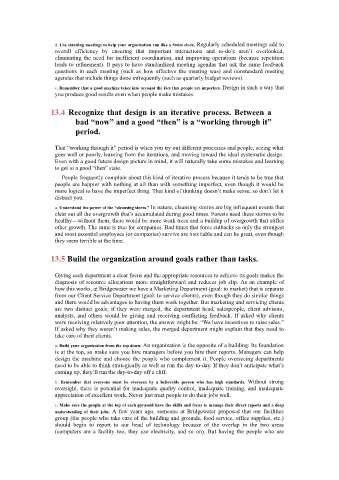Page 429 - Ray Dalio - Principles
P. 429
d. Use standing meetings to help your organization run like a Swiss clock. Regularly scheduled meetings add to
overall efficiency by ensuring that important interactions and to-do’s aren’t overlooked,
eliminating the need for inefficient coordination, and improving operations (because repetition
leads to refinement). It pays to have standardized meeting agendas that ask the same feedback
questions in each meeting (such as how effective the meeting was) and nonstandard meeting
agendas that include things done infrequently (such as quarterly budget reviews).
e. Remember that a good machine takes into account the fact that people are imperfect. Design in such a way that
you produce good results even when people make mistakes.
13.4 Recognize that design is an iterative process. Between a
bad “now” and a good “then” is a “working through it”
period.
That “working through it” period is when you try out different processes and people, seeing what
goes well or poorly, learning from the iterations, and moving toward the ideal systematic design.
Even with a good future design picture in mind, it will naturally take some mistakes and learning
to get to a good “then” state.
People frequently complain about this kind of iterative process because it tends to be true that
people are happier with nothing at all than with something imperfect, even though it would be
more logical to have the imperfect thing. That kind of thinking doesn’t make sense, so don’t let it
distract you.
a. Understand the power of the “cleansing storm.” In nature, cleansing storms are big infrequent events that
clear out all the overgrowth that’s accumulated during good times. Forests need these storms to be
healthy—without them, there would be more weak trees and a buildup of overgrowth that stifles
other growth. The same is true for companies. Bad times that force cutbacks so only the strongest
and most essential employees (or companies) survive are inevitable and can be great, even though
they seem terrible at the time.
13.5 Build the organization around goals rather than tasks.
Giving each department a clear focus and the appropriate resources to achieve its goals makes the
diagnosis of resource allocations more straightforward and reduces job slip. As an example of
how this works, at Bridgewater we have a Marketing Department (goal: to market) that is separate
from our Client Service Department (goal: to service clients), even though they do similar things
and there would be advantages to having them work together. But marketing and servicing clients
are two distinct goals; if they were merged, the department head, salespeople, client advisors,
analysts, and others would be giving and receiving conflicting feedback. If asked why clients
were receiving relatively poor attention, the answer might be: “We have incentives to raise sales.”
If asked why they weren’t making sales, the merged department might explain that they need to
take care of their clients.
a. Build your organization from the top down. An organization is the opposite of a building: Its foundation
is at the top, so make sure you hire managers before you hire their reports. Managers can help
design the machine and choose the people who complement it. People overseeing departments
need to be able to think strategically as well as run the day-to-day. If they don’t anticipate what’s
coming up, they’ll run the day-to-day off a cliff.
b. Remember that everyone must be overseen by a believable person who has high standards. Without strong
oversight, there is potential for inadequate quality control, inadequate training, and inadequate
appreciation of excellent work. Never just trust people to do their jobs well.
c. Make sure the people at the top of each pyramid have the skills and focus to manage their direct reports and a deep
understanding of their jobs. A few years ago, someone at Bridgewater proposed that our facilities
group (the people who take care of the building and grounds, food service, office supplies, etc.)
should begin to report to our head of technology because of the overlap in the two areas
(computers are a facility too, they use electricity, and so on). But having the people who are

